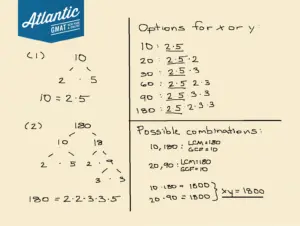If x and y are positive integers, what is the value of xy? GMAT Explanation + Additional Examples!
If x and y are positive integers, what is the value of xy?
(1) The greatest common factor of x and y is 10
(2) The least common multiple of x and y is 180
Define the question: What is the value of xy?
There’s not much to define here, but it’s important to note that x and y both are positive integers.
Organize the given information with prime factorization:
Since there’s not too much information from the question, let’s move to the given statements.
(1) The greatest common factor of x and y is 10.
Here’s a good refresher on greatest common factors from Khan Academy. Let’s think about this statement in terms of prime factors. The prime factorization of 10 is 2 * 5. From this statement, we know two things:
- x and y are multiples of 10 (10 is a factor of both)
- The only prime factors x and y have in common are a 2 and a 5.
With only this information, x and y can be any number of values — x could be 10 and y could be 20, 30, 40, etc. So, we don’t have a unique answer for xy with only statement 1.
Insufficient.
Let’s look at statement 2.
(2) The least common multiple of x and y is 180.
Here’s another refresher on least common multiples from Khan Academy.
Let’s make a guess that y = 180. Here, x could be 1, 2, 3, or any other factor of 180, as these all have a least common multiple of 180. So again, we can’t find a unique answer for xy using only statement 2.
Insufficient.
Let’s try both statements together.
For this, let’s go back to our prime factorization technique. The prime factorization for 180 is 2 * 2 * 3 * 3 * 5. Both x and y have the factors 2 and 5. So, x and y have to be 10 times some combination of the remaining factors: 2, 3, and 3.
Let’s write out all the possibilities for x and y:
10: 2 * 5
20: 2 * 2 * 5
30: 2 * 3 * 5
60: 2 * 2 * 3 * 5
90: 2 * 3 * 3 * 5
180: 2 * 2 * 3 * 3 * 5
Let’s find which combinations of these have a least common multiple of 180. We know two things from statement 2:
- Only one of x and y has two 2’s in its prime factorization.
- Only one of x and y has 3’s in its prime factorization.
This is because x and y only have 2 and 5 as common prime factors. If they both had two 2’s or any 3’s, they would share more prime factors than just 2 and 5. This would violate statement 1. So, what are the possible combinations now?
- 10 and 60
- 10 and 180
- 20 and 90
We can rule out option 1 as the least common multiple of 10 and 60 is 60, not 180. However, both options 2 and 3 have a greatest common factor of 10 and a least common multiple of 180.
But, we are looking for the product of x and y. And sure enough these pairs both have a product of 1800. Therefore with both statements together, we can solve for xy, so both statements together are sufficient.
Answer: C
Here’s all of that worked out:
